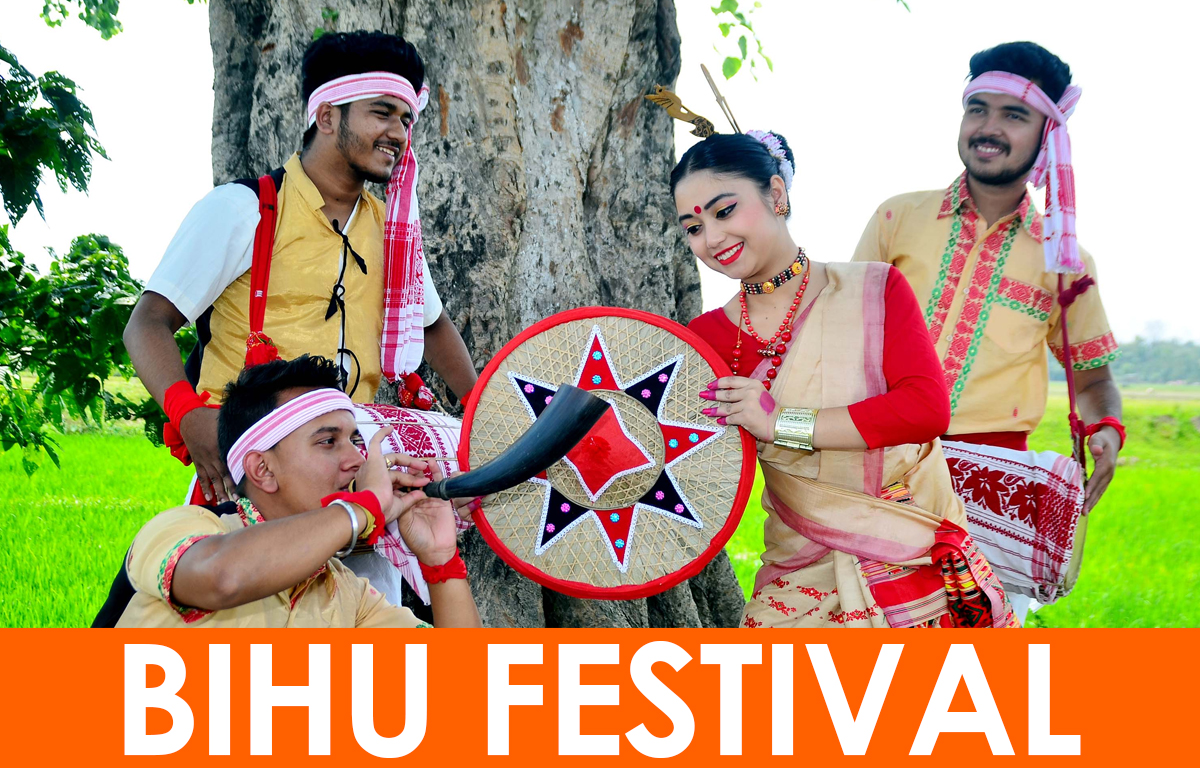Table of Contents
Bihu Festival
The three variations of the Bihu festival—Bohag Bihu, Kati Bihu, and Magh Bihu—all fall on significant dates in the area’s agricultural calendar. The Bohag Bihu holiday, which is observed in the middle of April, marks the start of spring and the cycle of crop sowing. The fast steps, swaying hips, and usage of traditional musical instruments like the dhol (drum), taal (cymbals), and pepa (horn) are characteristics of the dance.
The Bihu Festival of Assam is an important part of Indian Art and Culture which is an important subject in UPSC Syllabus. Students can also go for UPSC Mock Test to get more accuracy in their preparations.
Bihu Festival History
Rongali Bihu has a long history that dates back to the Assamese population’s primary vocation, which was agriculture. The Ahom rulers, who ruled Assam from the 13th to the 19th century, are thought to have been the ones who first observed the holiday. The Mising, Karbi, and Bodo are only a few of the Assamese ethnic groups that participated in the celebration. Assamese celebrate a harvest celebration called Magh Bihu to show their appreciation for a successful crop and to signal the end of the harvesting season.
It supports fostering a feeling of community and identity while sharing the benefits of nature. Bohag Bihu, Kati Bihu, and Magh Bihu are the three variations of the celebration of Bihu. Each of these is scheduled during the agricultural year. The Makar Sankranti, or the day when the sun starts moving northward or Uttarayan and enters the Hindu zodiac sign of Makara, is seen as fortunate in the Hindu lunar calendar as well.
Bihu Festival Features
The Tezpur and Darrang regions of Assam include the earliest representations of Bihu dance, which date to the ninth century. Inscriptions from the 14th-century Chutia King Lakshminaryan have also been cited by Bihu.Young men and women dancers cautiously enter the performance space before the dance even starts.
Male musicians start playing flutes, hornpipes and drums (particularly the double-headed dhol), while female musicians form an inverted triangle with their hands over their hips and palms facing outwards. The women then start to slowly move in rhythm with the music, swaying and bending forward slightly from the waist.
The Bohag Bihu Festival, also known as Rongali Bihu, which honours the Assamese New Year, is Assam’s national celebration and gives rise to the name of the Bihu dance. Bhogali or Magh Bihu was found in January, Rongali or Bohag Bihu was found in April, and Kongali or Kati Bihu was found in October. The Rongali Bihu, the most well-known of the three, honours the spring festival.
The harvest festival known as the Bhogali Bihu, also called the Magh Bihu, features communal feasts. The Kongali Bihu, often referred to as the Kati Bihu is a solemn, frugal celebration that honours a time of shortage. The Bihu dance, which is performed during the festival in mid-April, is meant to honour and imitate the seasonal mood while honouring fertility and love. A group of young men and women execute the dance known as Bihu, which was originally employed as a courting dance.
The sensual element of the dance links the Bihu dance to both human and natural fertility, which is expressed in the celebration of spring and the embrace of the life-giving spring rain. It is believed that using instruments like drums and hornpipes to simulate the sound of rain and thunder will cause real precipitation.
Bihu Festival Method of Celebration
The Bihu Festival’s first day, Goru Bihu, is devoted to the veneration of cows, which are revered as sacred animals in Assam. The festival’s second day, Manuh Bihu, is its centrepiece and features a lot of feasting and celebration. Gosai Bihu, the third day, is devoted to requesting blessings from the gods and goddesses. Senehi Bihu, the fourth day, is when people visit friends and family and exchange presents.
An important event with a strong foundation in Assamese agricultural and cultural traditions is rongali bihu. It’s an occasion for people to get together, appreciates their diverse cultural history, and foster social harmony.
Bihu Festival Significance
Rongali Bihu has a wide range of significance and value. First of all, it signals the start of the harvesting season and the entrance of spring. During the event, people express gratitude to the gods for a bountiful harvest and ask for their blessings for the future year. Second, Rongali Bihu honours Assam’s extensive cultural legacy.
It is a time when people congregate and take part in a variety of cultural pursuits, including folk dances, music, and sports. The celebration encourages social cohesiveness and communal harmony, too. Regardless of their ethnicity or religion, people from all groups join together to enjoy the holiday.
Bihu Festival Record 2023
On April 13, 2023, 11,304 dancers and musicians performed the traditional Assamese dance, Bihu, in Guwahati’s Sarusajai Stadium and broke two world records. Both the largest performance by folk musicians and the largest Bihu dance performance was set by the artists. The performers included more than 7,000 dancers, more than 3,000 dhol drummers, and other musicians.
Bihu Festival UPSC
The Bihu Festival, which has come to symbolise Assamese cultural identity, still maintains a significant place in contemporary Assamese society and is regarded as a cultural landmark. Prior to independence, the dance was mostly a rural phenomenon, but it has managed to survive rising urbanisation and is now accepted in the region’s urban centres.
The Bihu dance was first performed on stage as part of a cultural event in Guwahati in 1962. Students can read all the details related to UPSC by visiting the official website of StudyIQ UPSC Online Coaching.


 Daily Quiz 17 April 2025
Daily Quiz 17 April 2025
 Nilgiri Biosphere Reserve, Map, Climate,...
Nilgiri Biosphere Reserve, Map, Climate,...
 Complete List of Indian State Animals
Complete List of Indian State Animals





















